Advertisement

- Updated on May 19, 2025
- IST 5:39 am
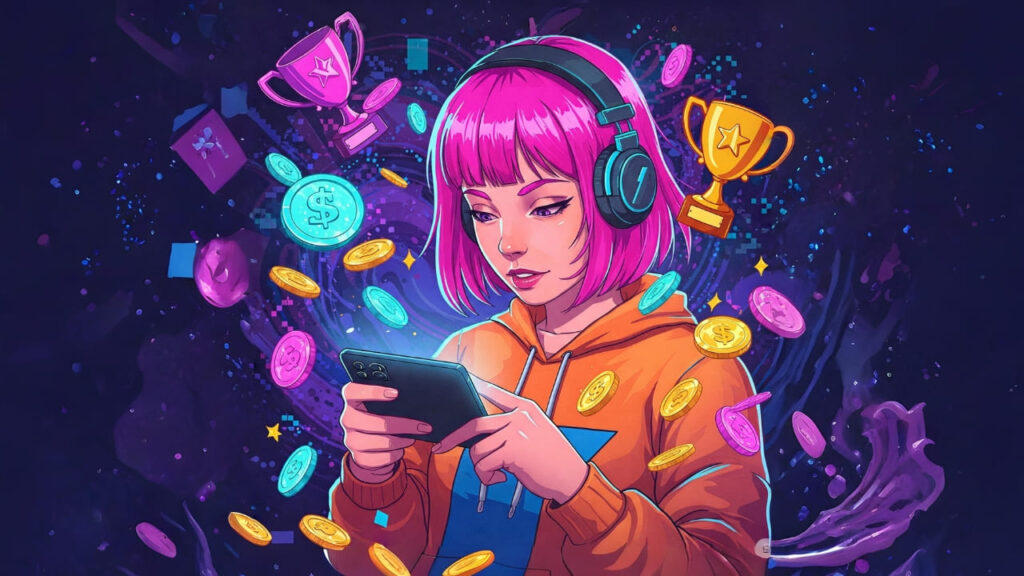
“Forget cricket—how mobile gaming made these Indians crorepatis overnight.” It’s a bold claim, but in 2025, it’s not just hype—it’s reality. Picture this: a 22-year-old from a small town in Uttar Pradesh, hunched over his smartphone, fingers flying across the screen. He’s not just playing; he’s competing in a high-stakes tournament on Mobile Premier League (MPL), where a single win could turn him into a crorepati. Across the country, in a bustling Mumbai café, a group of friends huddle around a phone, cheering as their fantasy team climbs the leaderboard on Rooter. This isn’t a niche hobby—it’s a cultural shift. India’s gaming startups have cracked the code, luring 200 million Gen Z gamers into a $5 billion market that’s redefining entertainment, ambition, and even wealth.
In a nation where cricket once reigned supreme, mobile gaming has staged a quiet revolution. Platforms like MPL and Rooter aren’t just games—they’re ecosystems where passion meets profit, and where Gen Z, the digital natives born between the late 1990s and early 2010s, have found their playground. But how did these startups pull off such a feat? How did they turn pixels into paychecks and transform casual gamers into crorepatis? Let’s dive into the story of India’s gaming boom, where startups are not just playing the game—they’re changing it.
The Explosion of India’s Gaming Market: From Niche to Necessity
India’s gaming industry isn’t just growing—it’s sprinting. In 2025, the market hit a staggering $5 billion, fueled by a perfect storm of affordable smartphones, lightning-fast internet, and a generation hungry for digital thrills. But this isn’t just about numbers; it’s about a shift in how Indians play, connect, and even dream. Gaming startups like MPL and Rooter didn’t just ride this wave—they helped create it.
Take MPL, for instance. Launched in 2018, it’s now a juggernaut with over 90 million users, offering everything from fantasy sports to puzzle games. What’s their secret? They tapped into India’s love for competition and rewards. “It’s not just about playing; it’s about winning,” says Sai Srinivas, MPL’s co-founder. “We’ve created a platform where anyone with a smartphone can compete and earn real money.” And they’re not kidding—top players on MPL have pocketed lakhs in a single tournament, turning gaming into a viable career path.
Then there’s Rooter, a sports fan engagement platform that’s become a hub for Gen Z’s sports obsession. With 8 million monthly active users, Rooter connects fans during live matches, offering features like live predictions and fantasy games. “We’re not just a gaming platform; we’re a community,” says Piyush Kumar, Rooter’s CEO. “Gen Z wants more than passive entertainment—they want to be part of the action.” And they are, with users spending an average of 45 minutes a day on the app, engaging in everything from cricket trivia to esports showdowns.
But what’s driving this boom? It’s simple: accessibility. With smartphones in nearly every hand and data plans cheaper than a cup of chai, gaming is no longer a luxury—it’s a lifestyle. Add to that the thrill of real-money rewards, and you’ve got a recipe for addiction. In 2025, India’s gaming market isn’t just big; it’s a goldmine, and startups like MPL and Rooter are the prospectors striking it rich.
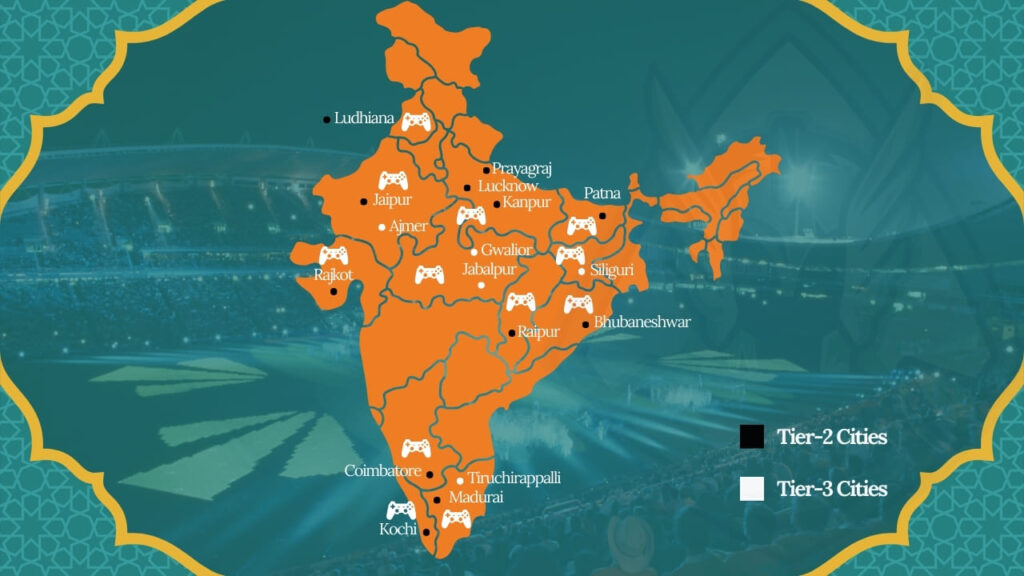
Gen Z: The Digital Natives Who Game to Win
If you want to understand why gaming startups are thriving, look no further than Gen Z. Born into a world of screens and swipes, this generation doesn’t just consume content—they create it, share it, and monetize it. For them, gaming isn’t a pastime; it’s a passion, a social glue, and increasingly, a paycheck.
Take Aarav, a 19-year-old from Pune. By day, he’s a college student; by night, he’s a gaming sensation on MPL, raking in ₹50,000 a month from tournament wins. “It started as a hobby,” he says, “but now it’s my side hustle. I’ve even bought my mom a new phone with my winnings.” Aarav isn’t alone—across India, Gen Z gamers are turning their skills into serious cash, and startups are cashing in too.
Why does Gen Z flock to these platforms? It’s a mix of thrill, community, and opportunity. Games like fantasy cricket on MPL let them flex their sports knowledge, while Rooter’s live match features make them feel like they’re part of the game. “It’s like being in the stadium, but better,” says Priya, a 24-year-old Rooter user from Delhi. “I can predict plays, chat with friends, and win prizes—all from my couch.”
But it’s not just about fun. For many, gaming is a ladder to financial freedom. In a country where traditional jobs can be scarce, platforms like MPL offer a tantalizing alternative. “I don’t need a degree to be good at gaming,” says Aarav. “I just need my phone and my skills.” It’s a sentiment echoed by millions, and it’s reshaping India’s economic landscape.

The Secret Sauce: How MPL and Rooter Captured Gen Z
So, how did MPL and Rooter crack the Gen Z code? It’s a blend of smart tech, savvy marketing, and a deep understanding of what makes this generation tick. Let’s break it down.
MPL: The All-in-One Gaming Hub
MPL’s genius lies in its diversity. With over 60 games ranging from fantasy sports to casual puzzles, it’s a one-stop shop for every kind of gamer. But what really sets it apart is its real-money gaming model. “We’ve gamified the entire experience,” says Srinivas. “Every game is a chance to win, and that keeps players coming back.”
MPL also leans heavily on localization. Games are available in multiple languages, and the platform partners with local influencers to reach deeper into India’s heartland. “We’re not just targeting metros,” Srinivas adds. “We’re going where the gamers are—Tier 2 and Tier 3 cities.” It’s working—over 60% of MPL’s users hail from smaller towns, proving that gaming’s appeal is universal.
Rooter: The Social Sports Network
Rooter, meanwhile, has mastered the art of community. By blending gaming with live sports, it’s created a space where fans don’t just watch—they participate. “We’re the WhatsApp for sports fans,” says Kumar. “It’s all about real-time interaction.” During the IPL, for example, Rooter’s live prediction games saw millions of users guessing outcomes, with top scorers winning cash prizes.
But Rooter’s real magic is its UGC (user-generated content) model. Fans create and share their own content—memes, videos, commentary—turning the platform into a buzzing hive of activity. “Gen Z loves to express themselves,” Kumar explains. “We give them the tools to do it.” The result? A sticky, addictive platform that keeps users engaged long after the final whistle.
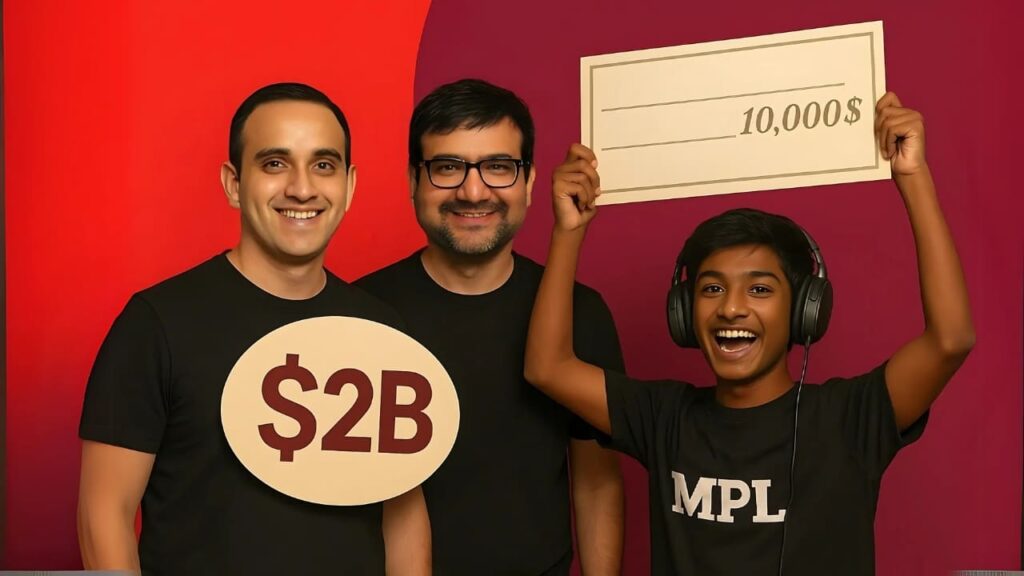
The Billionaire Effect: Turning Pixels into Paychecks
Now, let’s talk money. In 2025, India’s gaming startups aren’t just making waves—they’re making billionaires. Take Sai Srinivas and Shubh Malhotra, the brains behind MPL. With a valuation north of $2 billion, they’re not just crorepatis; they’re among India’s youngest billionaires. “It’s surreal,” says Malhotra. “We started with a simple idea—make gaming rewarding. Now, we’re changing lives.”
But the wealth isn’t just at the top. Gamers, too, are cashing in. In 2024 alone, MPL distributed over ₹1,000 crore in winnings, turning thousands of players into overnight crorepatis. “I won ₹5 lakh in a fantasy cricket league,” says Rohan, a 28-year-old from Bangalore. “It paid off my student loans.” Stories like his are popping up across India, fueling the gaming frenzy.
Rooter, while not focused on real-money gaming, has its own success stories. Top content creators on the platform earn lakhs through sponsorships and brand deals. “Gaming isn’t just a hobby anymore,” says Kumar. “It’s a career.” And with India’s gaming market projected to hit $7 billion by 2026, the opportunities are only growing.
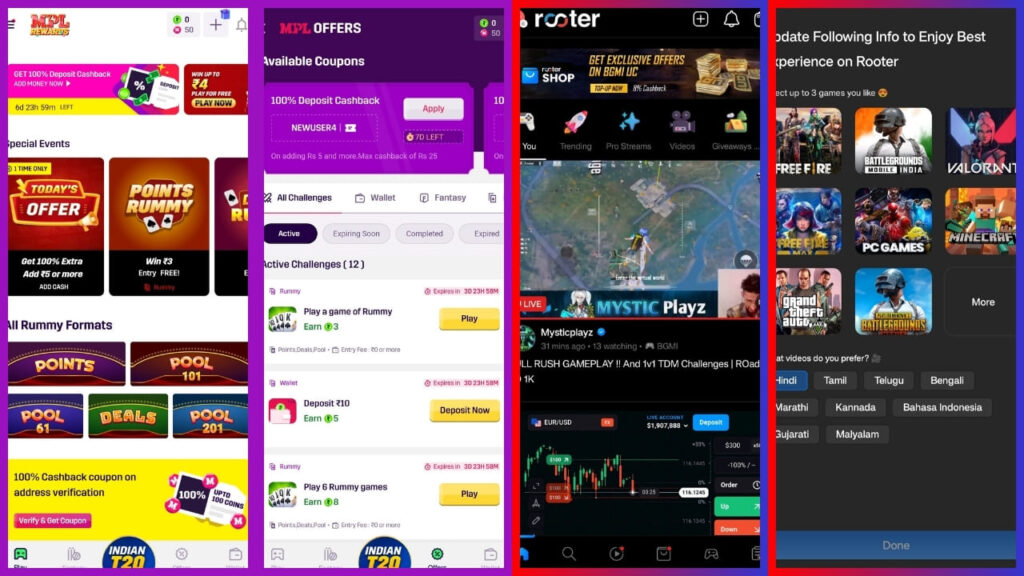
The Ripple Effect: Gaming’s Impact on India’s Economy and Culture
The gaming boom isn’t just filling pockets—it’s reshaping India’s economy and culture. Let’s start with jobs. The industry has created over 100,000 direct jobs in game development, content creation, and event management. Add in indirect roles—think cafes, tech support, marketing—and the number balloons. “Gaming is a goldmine for employment,” says Ankit Pandey, a gaming analyst. “It’s not just coders; it’s artists, writers, even psychologists designing addictive gameplay.”
Culturally, gaming is knitting India together. In a country as diverse as ours, it’s a universal language. “I’ve made friends from Kerala to Kashmir through gaming,” says Aarav. “We don’t speak the same tongue, but we speak the same game.” It’s a sentiment echoed by millions, and it’s turning gaming into a social glue.
But there’s a flip side. With great power comes great responsibility, and gaming’s addictive nature has sparked concerns. “We need to promote responsible gaming,” says Dr. Neha Gupta, a psychologist. “It’s easy to get hooked, especially with real money at stake.” Startups are listening—MPL, for instance, has introduced time limits and self-exclusion options. But as the market grows, so does the need for balance.
What’s Next: The Future of Gaming in India
So, where does India’s gaming juggernaut go from here? The sky’s the limit. With 5G rolling out and AR/VR tech on the horizon, the gaming experience is set to get even more immersive. “Imagine playing a fantasy cricket game in VR, where you’re on the field with your team,” says Srinivas. “That’s the future.”
Rooter, too, is eyeing expansion. “We’re looking at global markets,” says Kumar. “India’s gaming culture is unique, but the passion for sports is universal.” With plans to launch in Southeast Asia and the Middle East, Rooter’s ambition knows no bounds.
But perhaps the most exciting prospect is the rise of homegrown gaming IPs. “India’s gaming startups are creating games that reflect our culture,” says Pandey. “It’s not just PUBG clones; it’s games rooted in Indian mythology, history, and humor.” This localization could be the key to taking Indian gaming global.
Conclusion: Game On, India!
From dusty village lanes to gleaming city skyscrapers, gaming has woven itself into India’s fabric. Startups like MPL and Rooter haven’t just lured 200 million Gen Z gamers—they’ve sparked a revolution. They’ve turned passion into profit, play into paychecks, and in the process, they’ve made billionaires out of dreamers.
But this isn’t just a story of wealth; it’s a story of possibility. For every Aarav or Rohan, there are millions more waiting to turn their thumbs into gold. So, what’s your move? Will you join the game or watch from the sidelines? Drop your thoughts below, and let’s keep the gaming fever alive!
You May Like This
Advertisement
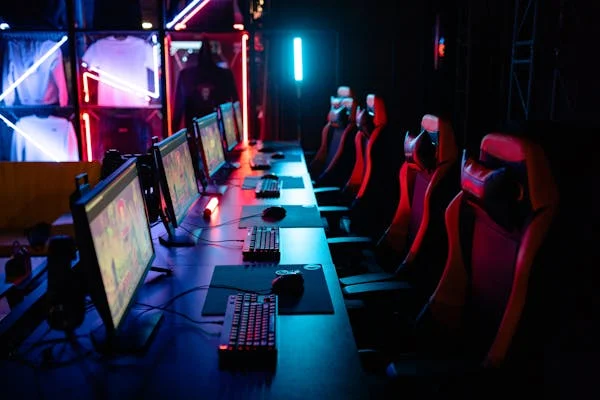
You May Like This








Advertisement

Advertisement

Advertisement





